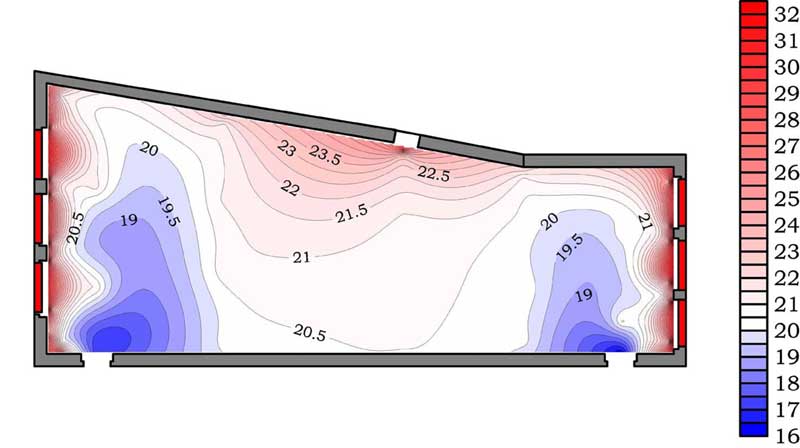
ABSTRACT
While the external climate has strongly influenced planning in the past, today modern technology creates the desired microclimate inside buildings with powerful systems to heating, ventilating, air conditioning (HVAC), and lighting. While in many cases highly satisfactory levels of comfort for people have been reached, the situation is rather more complex and problematical for the conservation of works of art. In some cases, the microclimate in museums is controlled for human welfare during opening times, and is left to evolve freely during the night. When the HVAC is switched on/off, the room environment undergoes abrupt changes, and also in the following it is continually perturbed by many factors. Field surveys show that the weak point of HVAC is not the production or absorption of heat or vapour, but rather the redistribution inside the rooms in order to obtain a climate which is homogeneous throughout the space and which is constant in time. Field surveys performed to do a sound environmental diagnostic in a number of European museums have found some weak point that are particularly common and that have been removed, or mitigated, after having been recognised. Some useful examples are as follows:

Fig. 1: Floor temperature (°C) with cold areas in front of two open doors determined by the entrance of air from the nearby cooler corridor. Room heating is made with radiators (red rectangles on the shorter sides) and floor heating. Hall of Giants, Padova (I), measurements taken in the occasion of a concert.
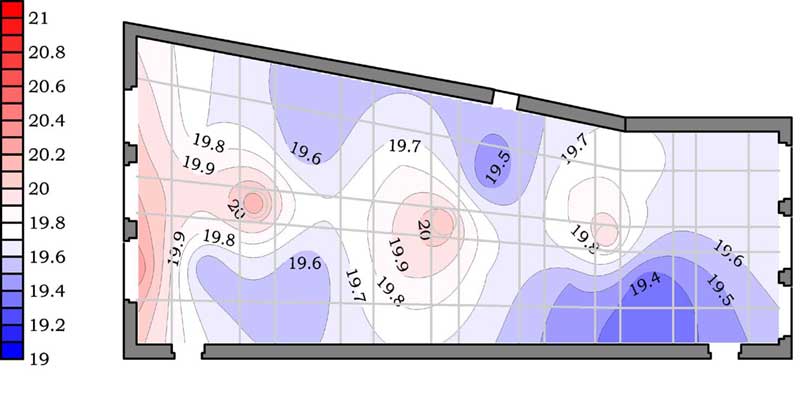
Fig. 2: Wooden ceiling temperature (°C) with hot spots determined by three chandeliers with 20 compact fluorescent lamps. Hall of Giants, Padova (I), measurements taken in the occasion of a concert.
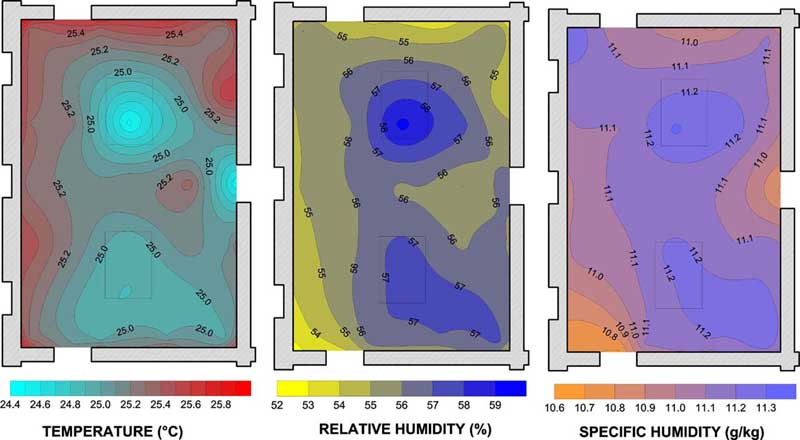
Fig. 3: Effect of air conditioning with emission in the middle of the Bruegel Room, Kunsthistorisches Museum, Vienna (A). The air with different temperature and moisture content is appropriately released far from the paintings. The entrance of cooler air from the room on the right is also evident.
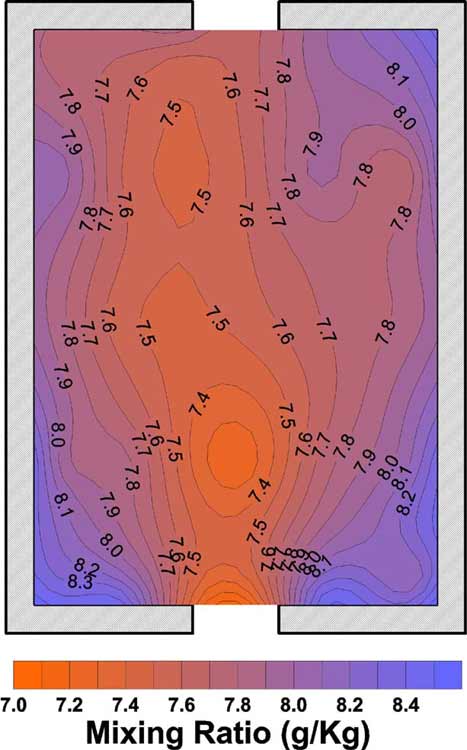
Fig. 4: Horizontal distribution of the mixing ratio inside a room in the Koninklijk Museum voor Schone Kunsten (KMSK), Antwerp (B). This parameter pinpoints the entrance of air from the door in the lower part of the drawing and shows how it spreads into the room.
The indoor microclimate conditions should be controlled also with the aim of reducing to a minimum the deposition rate of pollutants on surfaces. This requires that the air and the wall temperature are always at the same level, the floor is colder than the ambient air and the ceiling warmer. If things are different, convective motions develop, with the result of depositing suspended particles on the room walls and ceiling at high rate via aerodynamic deposition
Technology can not always resolve the various problems that arise, nor can it always reconcile mass tourism with conservation, which are hardly compatible each other. We cannot define a microclimate, or microclimate changes, absolutely safe for conservation in general terms, but we should look at the impact it causes on the individual artworks, especially the most delicate ones. A problem is that we can detect the most evident and immediate damages, not what will happens in the long term as a result of the cumulative effect of many cycles. An agreement about the thresholds of the allowed microclimate perturbation is still lacking, and we need more laboratory tests and field surveys to better relate environmental causes, artworks response and damage assessment.
The study of the microclimate for the conservation of works of art presents various difficulties. First among them is the fact that appropriate measuring instruments are not always available since, basically, only instruments designed for other uses are commercially available. The study of interactions between works of art and the environment requires knowledge of the physical parameters which characterise the object and the corresponding atmospheric values. Rarely can the same instrument be used to measure both the object and the environment Valid instrumentation is often unavailable to measure objects of art while satisfying both requirements of precision and absolute respect for the work of art, which on its own would require only no-contact measurements.
It is not easy to measure the temperature of an artwork which cannot be handled following a style well established for industrial or meteorological purposes. Contact measurements are always difficult because of the incomplete adhesion of the probe to the surface of the artwork that may be rough or uneven. In the industrial field adhesives are sold to improve thermal contact, but their use on artworks is inappropriate when they stain the surface. In case of paintings on canvas or isolated sheets of paper, the thermal capacity of the sensor is much greater than that of the artistic work, so that in this case it is the thermometer which imposes its temperature on the object, and not vice versa. Whenever possible, for non-metallic works of art, or for highly oxidised metallic objects, it is preferable to take thermal measurements based on the infrared emissions of the object. In this case the sensor should be placed inside a golden metallic cup, so that it is shielded from the radiation of the external environment and it will collect all the direct and reflected radiation emitted from its surface. Under these conditions, measurements are independent of the specific emissivity of the surface and may reach values of high precision, if the electric circuit compensates for the thermal drift of the instrument. Unfortunately, most of the instruments in the market are not adequately compensated for to reach a high accuracy.
To further complicate matters, the characteristics reported in the technical sheets of commercial instruments are sometimes ambiguous. In some cases the factory declares the characteristics of the sensors, without specifying how these are transformed by the presence of the casing and the whole chain connected to the measurement. The most common consequence is a major increase in the time response with significant repercussions on temperature measurements and, above all, on humidity.
For example, Fig. 5 below gives the results of a commercial hygrometer with nominal response-time of the order of 1 minute, placed in a climatic chamber, the square wave cycles going from 0 to 100% of relative humidity (RH) in a 45 min period. The sensor is very quick, but, once placed in its plastic support, it undergoes such inertia that in every cycle, it reaches only 40%. If some of the plastic is removed from the less essential parts of the casing, measurements reach 60%; if all the plastic is removed leaving the sensor practically isolated, but next to the supply line and control panel, 70% is reached. If the instrument is calibrated in the laboratory and left long enough, it becomes precise. The problem is that the declared response-time only reflects the characteristics of the isolated sensor and not the whole instrument, which is unsuitable for dynamic field measurements as it provides unreliable data.
Fig. 5:
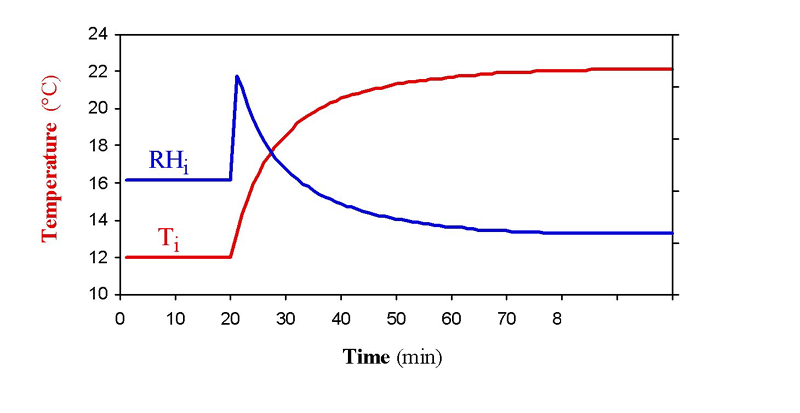
Author to whom correspondence may be addressed:
Dario Camuffo
National Research Council
Institute of Atmospheric Sciences and Climate
Corso Stati Uniti 4, I-35127 Padova
Italy
E-mail: d.camuffo@isac.cnr.it
[ Page up ] [ IAP Group homepage ] [ Main IAQ in Museums homepage ] [ Search site ]
Indoor Air Quality in Museums and Archives
© March 18th, 2002